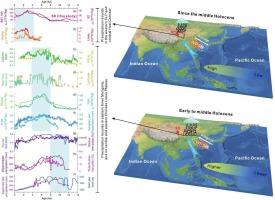西太平洋副热带高压调节了全新世东亚夏季风降水的时空格局
IF 2.7
2区 地球科学
Q2 GEOGRAPHY, PHYSICAL
Palaeogeography, Palaeoclimatology, Palaeoecology
Pub Date : 2025-08-28
DOI:10.1016/j.palaeo.2025.113252
引用次数: 0
摘要
东亚夏季风(EASM)降水对中国生态环境、气候和经济产生了重要影响。然而,造成东亚季风降水时空格局的机制尚不清楚。本文报道了一份全新世河西走廊黄土古土壤记录。环境磁参数(χ f、χfd、χARM/SIRM、χfd/HIRM)表明,14 ~ 8 ka降水偏少,4 ~ 2 ka降水偏多。综合已发表的记录,我们的研究结果揭示了全新世最大降水时间的明显地理梯度:内蒙古东部为全新世早期峰值,中国黄土高原中东部为全新世中期峰值,中国黄土高原西部和河西走廊中部为全新世晚期峰值。除了这些地带性差异外,我们还观察到全新世降水高峰的时间在纵向上的差异,南部地区比北部地区晚。结合已有的古气候和气候模拟结果,我们认为这种全新世降水峰值时间的空间差异反映了与西太平洋副热带高压西伸北移有关的东亚地区降雨带的移动。总的来说,我们的发现为东亚季风影响最西端边界的位置提供了证据,并为东亚季风降水及其时间的区域差异提供了统一的解释。本文章由计算机程序翻译,如有差异,请以英文原文为准。

Western Pacific subtropical high regulated the spatiotemporal pattern of East Asian summer monsoon precipitation during the Holocene
The precipitation delivered by the East Asian summer monsoon (EASM) has significantly influenced the ecological environment, climate, and economy of China. However, the mechanisms responsible for the spatiotemporal pattern of EASM precipitation remain unclear. We present a new Holocene loess-paleosol record from the Hexi Corridor on the EASM margin. Environmental magnetic parameters (χlf, χfd, χARM/SIRM, and χfd/HIRM) indicate that precipitation was low during 14–8 ka and then increased to a maximum during 4–2 ka. Integrated with published records, our results reveal a distinct geographical gradient in the timing of the Holocene precipitation maximum: an early Holocene peak in eastern Inner Mongolia, a mid-Holocene peak in the central and eastern Chinese Loess Plateau (CLP), and a late Holocene peak in the western CLP and central Hexi Corridor. In addition to these zonal differences, we also observed a longitudinal difference in the timing of the Holocene precipitation peak, which occurred later in the southern region than in the northern region. Combined with existing paleoclimate and climate simulation results we propose that this spatial difference in the timing of the Holocene precipitation peak reflects the movement of the EASM rainfall belt related to the westward extension and northward shift of the western Pacific subtropical high. Overall, our findings provide evidence for the location of the westernmost boundary of EASM influence and offer a unified explanation for regional differences in EASM precipitation and its timing.
求助全文
通过发布文献求助,成功后即可免费获取论文全文。
去求助
来源期刊
CiteScore
5.90
自引率
10.00%
发文量
398
审稿时长
3.8 months
期刊介绍:
Palaeogeography, Palaeoclimatology, Palaeoecology is an international medium for the publication of high quality and multidisciplinary, original studies and comprehensive reviews in the field of palaeo-environmental geology. The journal aims at bringing together data with global implications from research in the many different disciplines involved in palaeo-environmental investigations.
By cutting across the boundaries of established sciences, it provides an interdisciplinary forum where issues of general interest can be discussed.

 求助内容:
求助内容: 应助结果提醒方式:
应助结果提醒方式:


